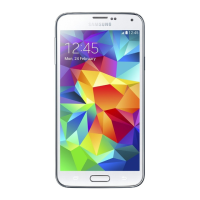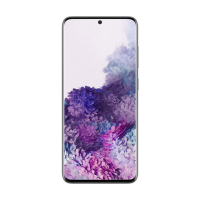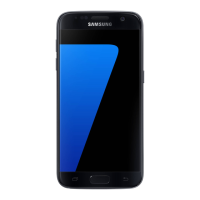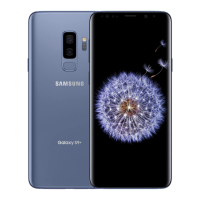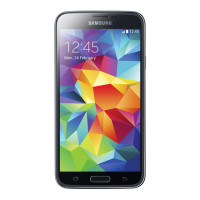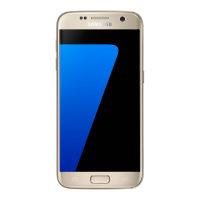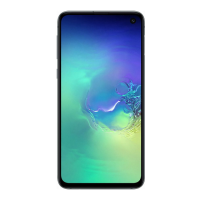Do you have a question about the Samsung SM-G950F and is the answer not in the manual?
Essential information and warnings before using the device.
Guidelines to preserve the device's water and dust resistance.
Steps to take when the device heats up during charging or use.
Explanation of symbols used in the manual for warnings, cautions, and notices.
Overview of the device's physical components and their purposes.
List of items included in the product box for the device.
Information and management of the device's battery power.
Step-by-step guide on how to charge the device's battery correctly.
Tips and settings to conserve battery power and extend usage time.
Important advice and warnings related to charging the device's battery.
Explanation of the built-in fast charging feature for quicker battery replenishment.
Guide to using the device's wireless charging coil and compatible chargers.
Information about installing and managing the SIM or USIM card.
Step-by-step instructions for inserting the SIM or USIM card into the device.
Details on installing, removing, and using a microSD memory card.
Instructions for correctly inserting a memory card into the device.
Procedures for powering the device on, off, and restarting it.
Guide through the first-time setup process after turning on the device.
Introduction to the integrated Samsung account service and its benefits.
Methods for moving data from an old device to the new one.
Information on how to interact with the device's touchscreen.
Guidelines and tips for proper touchscreen usage and care.
Explanation of the on-screen navigation buttons and their functions.
Information on how to lock and unlock the device screen for security.
Methods for capturing screenshots and using additional capture options.
How to access and manage notifications and quick settings.
Information about the keyboard layout and text input methods.
Guide to downloading, installing, and removing applications from the device.
Introduction to Bixby as a personal assistant for convenient smartphone use.
How to schedule notifications, to-do items, and location-based reminders.
Instructions for making and receiving voice and video calls.
Managing contact information, including adding and importing contacts.
Sending, viewing, and managing text messages.
Browsing the web, searching for information, and bookmarking pages.
Setting up and managing email accounts for sending and receiving emails.
Taking photos and recording videos using various modes and settings.
Fundamental techniques for taking photos and recording videos.
Overview of different camera shooting modes and their uses.
Viewing, managing, and sharing photos and videos.
Viewing information like clock or calendar on the screen when it's turned off.
Accessing favorite apps, contacts, and tasks from the Edge panels.
Running two apps simultaneously in a split-screen view.
Mobile payment service for quick and secure transactions using cards.
Tracking wellness and fitness goals, monitoring progress, and viewing health tips.
Recording voice memos, converting speech to text, and distinguishing sound sources.
Accessing and managing files stored on the device and in cloud services.
Setting alarms, checking world times, timing events, and using the stopwatch/timer.
Organizing and launching games, and setting device performance modes.
Connecting to and controlling nearby devices, home appliances, and IoT products.
Using the smartphone as a computer by connecting to an external display.
How to connect the smartphone to a TV or monitor via HDMI.
Overview of Google applications like Chrome, Gmail, Maps, and Drive.
Managing network connections like Wi-Fi and Bluetooth.
Activating and using Wi-Fi to connect to networks and the internet.
Exchanging data with other Bluetooth-enabled devices and pairing.
Using NFC for contactless payments and reading product information tags.
Sharing the device's mobile data connection with other devices.
Activating and customizing settings for dual SIM cards.
Adjusting volume levels, ringtones, and vibration settings.
Customizing notification settings for each application.
Adjusting screen brightness, resolution, and display settings.
Reducing eye strain by adjusting the screen's blue light emission.
Selecting screen modes and optimizing color balance for preference.
Changing the display resolution to enhance vividness or conserve battery.
Activating and configuring special device functions for enhanced usability.
Overview of device status and automatic optimization for performance.
Monitoring battery power, usage time, and activating power saving features.
Securing the device and SIM/USIM card with various lock methods.
Registering and using fingerprints for device security and authentication.
Enabling and using iris scanning for enhanced device security and authentication.
Securely verifying identity using biometrics for apps and websites.
Protecting private content and apps in a separate, secured storage area.
Managing cloud data, accounts, and device backups.
Configuring settings to improve device usability for users with impairments.
Customizing system settings, language, and resetting the device.
Features to make the device easier to use for users with impairments.
Activating and controlling the device using voice commands and feedback.
Using various finger gestures to navigate and control the device interface.
Solutions for common device issues and error prompts.
Essential information and warnings before using the device.
Guidelines to preserve the device's water and dust resistance.
Steps to take when the device heats up during charging or use.
Explanation of symbols used in the manual for warnings, cautions, and notices.
Overview of the device's physical components and their purposes.
List of items included in the product box for the device.
Information and management of the device's battery power.
Step-by-step guide on how to charge the device's battery correctly.
Tips and settings to conserve battery power and extend usage time.
Important advice and warnings related to charging the device's battery.
Explanation of the built-in fast charging feature for quicker battery replenishment.
Guide to using the device's wireless charging coil and compatible chargers.
Information about installing and managing the SIM or USIM card.
Step-by-step instructions for inserting the SIM or USIM card into the device.
Details on installing, removing, and using a microSD memory card.
Instructions for correctly inserting a memory card into the device.
Procedures for powering the device on, off, and restarting it.
Guide through the first-time setup process after turning on the device.
Introduction to the integrated Samsung account service and its benefits.
Methods for moving data from an old device to the new one.
Information on how to interact with the device's touchscreen.
Guidelines and tips for proper touchscreen usage and care.
Explanation of the on-screen navigation buttons and their functions.
Information on how to lock and unlock the device screen for security.
Methods for capturing screenshots and using additional capture options.
How to access and manage notifications and quick settings.
Information about the keyboard layout and text input methods.
Guide to downloading, installing, and removing applications from the device.
Introduction to Bixby as a personal assistant for convenient smartphone use.
How to schedule notifications, to-do items, and location-based reminders.
Instructions for making and receiving voice and video calls.
Managing contact information, including adding and importing contacts.
Sending, viewing, and managing text messages.
Browsing the web, searching for information, and bookmarking pages.
Setting up and managing email accounts for sending and receiving emails.
Taking photos and recording videos using various modes and settings.
Fundamental techniques for taking photos and recording videos.
Overview of different camera shooting modes and their uses.
Viewing, managing, and sharing photos and videos.
Viewing information like clock or calendar on the screen when it's turned off.
Accessing favorite apps, contacts, and tasks from the Edge panels.
Running two apps simultaneously in a split-screen view.
Mobile payment service for quick and secure transactions using cards.
Tracking wellness and fitness goals, monitoring progress, and viewing health tips.
Recording voice memos, converting speech to text, and distinguishing sound sources.
Accessing and managing files stored on the device and in cloud services.
Setting alarms, checking world times, timing events, and using the stopwatch/timer.
Organizing and launching games, and setting device performance modes.
Connecting to and controlling nearby devices, home appliances, and IoT products.
Using the smartphone as a computer by connecting to an external display.
How to connect the smartphone to a TV or monitor via HDMI.
Overview of Google applications like Chrome, Gmail, Maps, and Drive.
Managing network connections like Wi-Fi and Bluetooth.
Activating and using Wi-Fi to connect to networks and the internet.
Exchanging data with other Bluetooth-enabled devices and pairing.
Using NFC for contactless payments and reading product information tags.
Sharing the device's mobile data connection with other devices.
Activating and customizing settings for dual SIM cards.
Adjusting volume levels, ringtones, and vibration settings.
Customizing notification settings for each application.
Adjusting screen brightness, resolution, and display settings.
Reducing eye strain by adjusting the screen's blue light emission.
Selecting screen modes and optimizing color balance for preference.
Changing the display resolution to enhance vividness or conserve battery.
Activating and configuring special device functions for enhanced usability.
Overview of device status and automatic optimization for performance.
Monitoring battery power, usage time, and activating power saving features.
Securing the device and SIM/USIM card with various lock methods.
Registering and using fingerprints for device security and authentication.
Enabling and using iris scanning for enhanced device security and authentication.
Securely verifying identity using biometrics for apps and websites.
Protecting private content and apps in a separate, secured storage area.
Managing cloud data, accounts, and device backups.
Configuring settings to improve device usability for users with impairments.
Customizing system settings, language, and resetting the device.
Features to make the device easier to use for users with impairments.
Activating and controlling the device using voice commands and feedback.
Using various finger gestures to navigate and control the device interface.
Solutions for common device issues and error prompts.
| RAM | 4 GB |
|---|---|
| Internal Storage | 64 GB |
| Battery | 3000 mAh, non-removable |
| SIM | Single SIM (Nano-SIM) or Hybrid Dual SIM (Nano-SIM, dual stand-by) |
| Weight | 155 g (5.47 oz) |
| Dimensions | 148.9 x 68.1 x 8 mm (5.86 x 2.68 x 0.31 in) |
| Build | Glass front (Gorilla Glass 5), glass back (Gorilla Glass 5), aluminum frame |
| Network | GSM / HSPA / LTE |
| Bluetooth | 5.0, A2DP, LE, aptX |
| USB | USB Type-C 3.1 |
| Sensors | Iris scanner, fingerprint (rear-mounted), accelerometer, gyro, proximity, compass, barometer, heart rate, SpO2 |
| Colors | Midnight Black, Orchid Gray, Arctic Silver, Coral Blue, Maple Gold, Rose Pink, Burgundy Red |
| Model | Samsung SM-G950F (Galaxy S8) |
| Display | 5.8 inches, 1440 x 2960 pixels |
| Processor | Exynos 8895 Octa |
| Expandable Storage | microSD, up to 256GB |
| Rear Camera | 12 MP, f/1.7, 26mm (wide), PDAF, OIS |
| Front Camera | 8 MP, f/1.7, 25mm (wide), AF |
| Operating System | Android 7.0 (Nougat), upgradable to Android 9.0 (Pie); One UI |
| Charging | Fast charging 15W, Wireless charging (Qi/PMA) |



